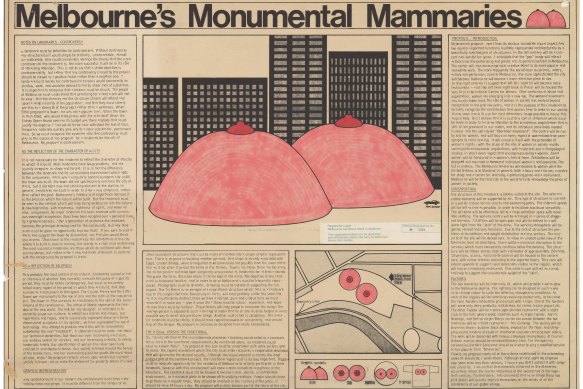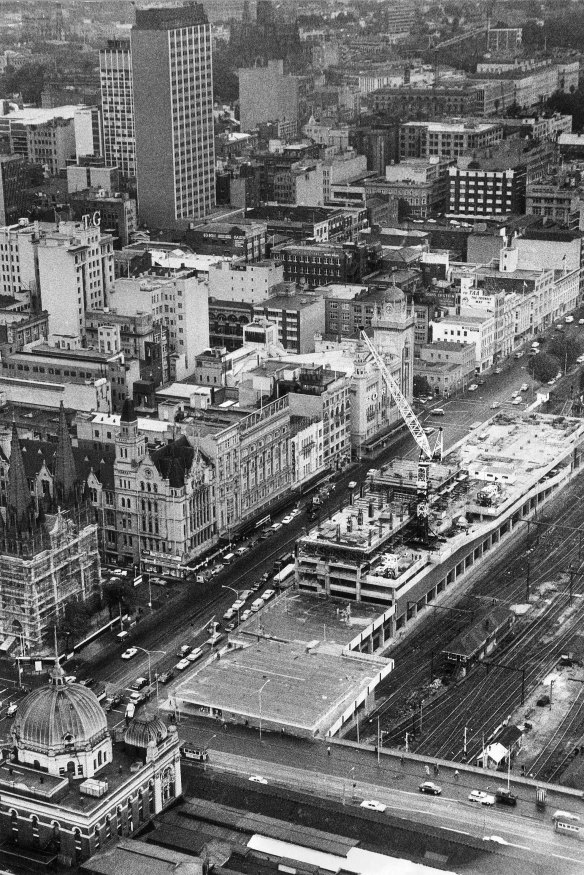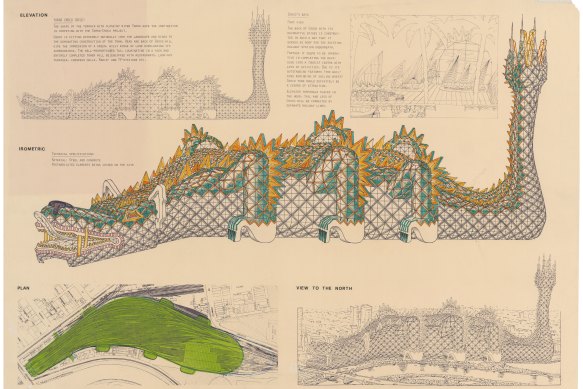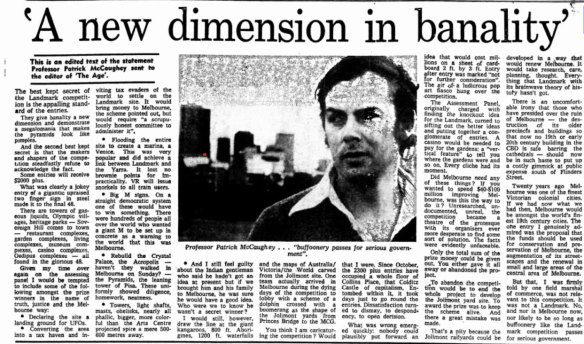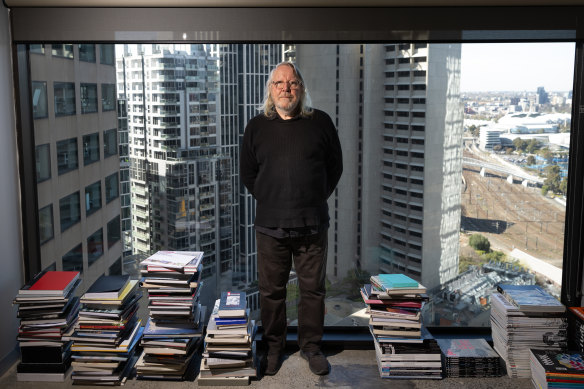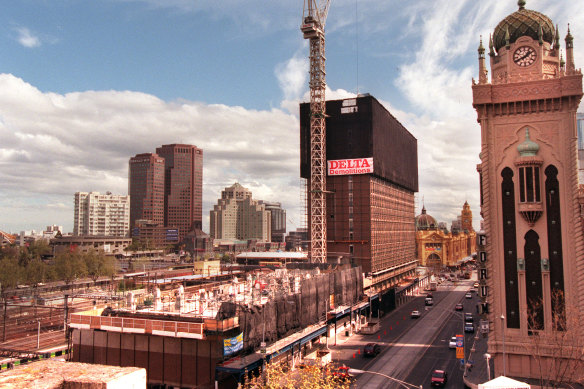
By Jewel Topsfield and Royce Millar
The Melbourne Landmark Competition was shelved after many controversial proposals for what is now Federation Square.Credit: Illustration: Matt Davidson
Save articles for later
Add articles to your saved list and come back to them any time.
Imagine Melbourne without Federation Square.
Think of an alternative landmark; two pink breast-shaped mounds housing an international women’s centre, perhaps, with revolving restaurants in the nipples.
Or an enormous steel V. Or a giant crocodile with a tail twice the height of the Rialto tower. Or even a UFO restaurant.
In 1978, the Victorian government – desperate for a monument to rival the Sydney Opera House – launched an international competition for a landmark to put Melbourne on the map.
A Melbourne Landmark Competition entry: Peter Deutsch, Westmount, Quebec, Canada; “Melbourne’s Monumental Mammaries”.Credit: Public Record Office Victoria, VPRS 2869/P0002, 3352
The competition, which attracted 2300 entries including the idiosyncratic proposals above, turned into a fiasco. One of the judges lampooned it as “theatre of the absurd” and premier Rupert Hamer was forced to concede “no single brilliant idea” had emerged.
Melbourne’s riposte to the Opera House was never built opposite Flinders Street Station.
But urban design experts say the landmark competition – derided at the time – stimulated debate about the potential of the site as a symbolic gateway and meeting place, paving the way for the creation of Federation Square.
And 45 years after the competition sought a project that would roof over the ugly spaghetti junction of the Jolimont rail yards, the Victorian government is still struggling with how to develop the challenging site now known as Federation Square East.
In a three-part series to commemorate the 21st anniversary of Federation Square, The Age will explore Melbourne’s controversial quest for a monument of its own, the future of the square and the thwarted civic dream of premiers dating back to Henry Bolte to build a deck over the rail yards.
‘A glorious farce’
In 1978, Ted Baillieu was a young architect from the Geelong and Melbourne-based practice McGlashan Everist when premier Rupert Hamer called for a world-class landmark to cover up the city rail yards.
A prize of $100,000 was offered to the entrant who could conjure up a wonder of the world to rival the Pyramids, Disneyland or the Eiffel Tower, that could attract millions of visitors to a city mocked more than once as being at the end of the world.
The competition asked for “an idea, a word, image or plan”. “It was very conceptual — I think you got two sheets of paper,” Baillieu recalls.
The final cost was estimated to be around $300 million, with the edifice to be unveiled during Australia’s bicentenary celebrations in 1988.
The 13-person Melbourne Landmark Committee, which was chaired by the voluble former lord mayor Ron Walker, met monthly in The Age’s boardroom.
Former Age editor-in-chief Ranald Macdonald says the newspaper agreed to publicise the competition.
“We thought The Age should be a centre for ideas,” Macdonald says. “The concept was to see if there was any great idea that Melbourne could embrace. I suppose we were seeking an Opera House, really.”
McGlashan Everist – which had won architecture awards for the designs of Grimwade House and Heide Museum – saw the landmark competition as an opportunity to return the Yarra River valley to the people of Melbourne.
“Everyone had gone around looking at city landmarks around the world – Melbourne versions of the St Louis Gateway Arch,” Baillieu says.
McGlashan Everist did not believe the landmark should be a “large scale man-made gesture”. Its entry proposed an urban village on the riverbank, built in part over the rail yards, and the restoration of what was then known as Flinders Park.
The architecture firm said development of the south front of the city had been inhibited by the blight of the rail yards and that a landmark would release this potential.
The Gas and Fuel Corporation towers were under construction in 1966.Credit: Fairfax Photographic
Decades later, after he was elected premier of Victoria in 2011, Baillieu would tell a Geelong newspaper of the competition’s city-shaping legacy.
“I recall the landmark competition run by then premier Rupert Hamer in the late 1970s, which 20 years later saw the development of Federation Square and led to the development of Melbourne’s Southbank,” he said in 2011.
But at the time the competition was ridiculed due to the high volume of outlandish and zany entries.
Alongside proposals from well-known architectural firms such as McGlashan Everist were Melbourne’s Monumental Mammaries, Yarra Croco(dile), boxing kangaroos, a giant fish garden, a Big M, a cricket wicket, a conch garden, a human hand shaped building and multiple entries with an extraterrestrial theme, presumably influenced by the 1977 film Close Encounters of the Third Kind.
“It was a glorious farce,” recalls former advertising executive Phillip Adams, one of the eight judges.
“We live in the land where we like building huge bananas and giant prawns and most of the ideas were in that vein – wild extrapolations and things from outer space.
“Bloated and immense statues or laser lights that could be seen from the moon and say, ‘Hey, we’re here’.”
A Melbourne Landmark Competition entry: B. Weber, Dietikon, Switzerland; “Yarra Croco (Dile)“.Credit: Public Record Office Victoria, VPRS 2869/P0002, 1441
Another judge, art critic Patrick McCaughey, explosively lambasted the “appalling standard” of the entries in a letter to The Age, effectively sabotaging the competition before any winner was announced.
“They give banality a new dimension and demonstrate a megalomania that make the pyramids look like pimples,” he fumed.
Just days later, the judges admitted they hadn’t been able to name a stand-alone winner and that the $100,000 prize money would be shared among 48 entrants.
Hamer never got the landmark he had hoped would define his premiership and the competition was widely considered a giant folly.
Patrick McCaughey’s view of the Melbourne Landmark Competition, published in The Age in 1979.Credit: The Age
Good ideas, but a wasted opportunity
Dr Derham Groves, a senior fellow from the faculty of architecture at the University of Melbourne, says the notion that all the entries were jokey and low quality is untrue.
While the competition was open to anyone, some of the entries were from high-profile architects and artists.
These included English architect Cedric Price; Japanese sculptor Tara Okamoto; Czech architect Jan Kaplicky, who designed the media centre at Lord’s Cricket Ground; American architect Harry Weese, who designed railway stations in Washington; Bates, Smart and McCutcheon; Denton Corker Marshall, who designed Melbourne Museum and Bolte Bridge; and Mario Oliveri, the architect who helped design Olivetti typewriters.
Forty-five years ago, architect John Denton from Denton Corker Marshall entered a design competition suggesting a hanging garden and apartments looking onto the Yarra for the site now occupied by Federation Square.Credit: Jason South
Groves’ favourite entry – which he has no doubt could have worked on the site – was an urban farm by Cedric Price, with water jets that would make the building invisible at various times because it created its own cloud.
“The competition is a remarkable record of what people were thinking at the cutting edge of architecture and design at that time,” Groves says.
“It just shows how blinkered the authorities and everybody was at the time. The competition wasn’t a waste of time, but it was certainly a wasted opportunity.”
Denton Corker Marshall won $2000 for their design of a medium-density housing development on the banks of the Yarra called The Great Wall and Hanging Gardens of Melbourne.
The design featured a two-kilometre transparent wall enclosing a garden maze with bars and cafes linked by moving footpaths.
“We were involved in urban design, so we were responding to it in a sensible sort of way,” says John Denton, who 27 years later would be appointed the first state architect of Victoria.
“From our point of view, it was a serious entry on the fantastical side. We put a bit of effort in, and we thought we might win, but it was obviously too hard to come up with a winner for the jury because it was the world of wackiness mainly.”
The demolition of the Gas and Fuel Corporation towers in 1996.Credit: Andrew De La Rue
But while the competition descended into farce, Denton believes it kick-started a conversation about a better entrance to Melbourne than the modernist Gas and Fuel towers at the intersection of Flinders and Swanston streets, which blocked the skyline and were widely considered an eyesore.
“It also started to distil in people’s minds that the railway tracks weren’t the nicest way for Melbourne to be sitting on the river,” Denton says. “There was something missing there.”
Lord Mayor Sally Capp likes to think the submissions could be used as a source of inspiration if the competition was held again today.
“Since the 1970s, Melbourne has become known globally for its arts and events, and for often embracing the weird and wonderful. We’re a city that’s proud to be different,” she says. “Who knows, maybe the Hanging Garden of Melbourne pitch, or the giant hand idea, would today be beloved icons and part of our rich cultural heritage.”
In 1985, Denton Corker Marshall proposed demolishing one of the Gas and Fuel towers and building a large street-level plaza stretching across the rail yards, although that too came to nought.
More than a decade later, premier Jeff Kennett would finally announce the Gas and Fuel buildings would be demolished, and a large open space opened in time to celebrate the centenary of Australia’s Federation in 2001.
Architect and commentator Dr Norman Day believes it was the landmark competition that broke the ice.
“Melbourne was pretty benign about how we developed our city. There was a lot of reticence, certainly by the architectural profession, to argue for something a little more interesting and to take some risks,” Day says.
“The competition got us thinking about what can we do with the river and what can we do with this site. And as a result of that, we got Federation Square.”
The Morning Edition newsletter is our guide to the day’s most important and interesting stories, analysis and insights. Sign up here.
Most Viewed in National
Source: Read Full Article

